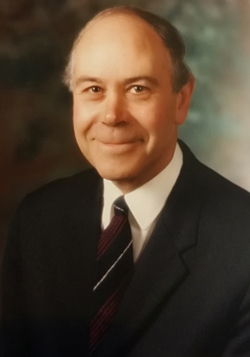Renowned field-based geophysicist noted for his work on gravity and magnetic anomalies and their geological interpretation

Martin was born in 1926 in Stoke-on-Trent, Staffordshire. He was educated at Clayesmore School in Dorset and Magdalene College, Cambridge. After military service in the Royal Signals in East Africa, where he climbed Mount Kilimanjaro, Martin took up a scholarship at Cambridge where he initially read Mathematics before switching to Natural Science.
Left, image credit: ©Godfrey Argent Studio. Reproduced with kind permission of The Royal Society.
In 1949 he joined the Cambridge Spitzbergen Expedition, climbing glacier-covered mountains and developing his passion for geology from field work and the collection of fossils. He received a D.Phil from Cambridge in 1954 for his work on gravity and magnetic anomalies in the Northern Pennines, supervised by Brian Harland. Martin spent his entire career at the University of Durham, being promoted to a Personal Chair in Geophysics in 1966 and serving as Head of Department (1970-3, 1976-82). He retired in 1988, but remained research active, and was elevated to Emeritus Professor in 1991 and awarded the Chancellors Medal in 2014.
Martin’s expertise was in geophysics, especially potential field observations, theory and interpretation. He acquired gravity and magnetic data onshore and offshore UK, and developed forward and inverse methods for the geological interpretation of gravity and magnetic anomalies. His earliest research focused on the northern Pennines, Cornwall, the Irish Sea, the Iceland-Faeroes Rise and the UK continental shelf and slope. He demonstrated how geophysics could be used to address important geological problems, such as the mechanism of granite emplacement, mountain building and sedimentary basin formation.
In 1970, Martin spent a sabbatical term at the Lamont-Doherty Geological Observatory of Columbia University, where he developed his interests in regional crust and upper mantle structure and the driving mechanisms of plate tectonics. His subsequent research focused on the formation processes of basins and rifted continental margins, tectonic stress within the lithosphere and the application of finite element methods to compute fault deformation.
Martin once said that his students were the main stimulus of his own research. He supervised more than 45 PhD students on a range of projects in geology, geophysics and mathematical computing. He was instrumental in setting up a MSc course in Advanced Geophysics and an Honours course in Geology and Geophysics at Durham, which trained generations of students in exploration geophysics. His success is reflected in his students, many of whom have gone on to leadership positions in industry, government and academia.
In recognition of his distinguished achievements, Martin received many awards and honours, including the Clough Medal of the Edinburgh Geological Society, and the Murchison and Wollaston Medals of the Geological Society of London. In 1977, he was elected a Fellow of the Royal Society.
Martin’s interests encompassed much more than geophysics. He was an avid mountaineer summiting all the peaks of the Monros, the Nuttalls and the Wainwrights in the British Isles. Along with his wife Joyce, Martin was a keen gardener. And for more than 5 decades he was an active member of St. Nicholas Church, Durham. His knowledge of the bible was extensive and he saw no conflict between his enduring Christian faith and his science.
Martin passed away on Saturday 20 October, 2018. He will be remembered by all who knew him as a humble, modest and gentle man. Perhaps his greatest legacy is his 154 journal publications and lucidly written and beautifully illustrated book “The interior of the Earth”. He leaves behind his wife, Joyce, children Andrew, Nicholas and Jacqueline, and 6 grandchildren. He will be greatly missed.
By Tony Watts and Nick Kusznir